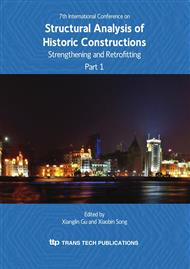p.373
p.379
p.385
p.391
p.397
p.403
p.411
p.417
p.423
Statistical Time Series Analysis of Crack Movements at Bayon Main Tower, Cambodia
Abstract:
Based on the past monitoring data of crack movements and various weather conditions by JASA (Japanese Government Team of Safeguarding Angkor), we quantitatively examine about the effects of each weather conditions to each crack movements at Bayon main tower. Then, we applied the time series analysis using a state-space representation in the examination. In the model of the state-space representation, the factors of crack movement are assumed as temperature, wind velocity and rainfall. Those quantitative examinations of crack movements will be necessary for the planning of reinforcement and restoration at Bayon main tower.
Info:
Periodical:
Pages:
397-402
Citation:
Online since:
October 2010
Authors:
Price:
Сopyright:
© 2010 Trans Tech Publications Ltd. All Rights Reserved
Share:
Citation:



